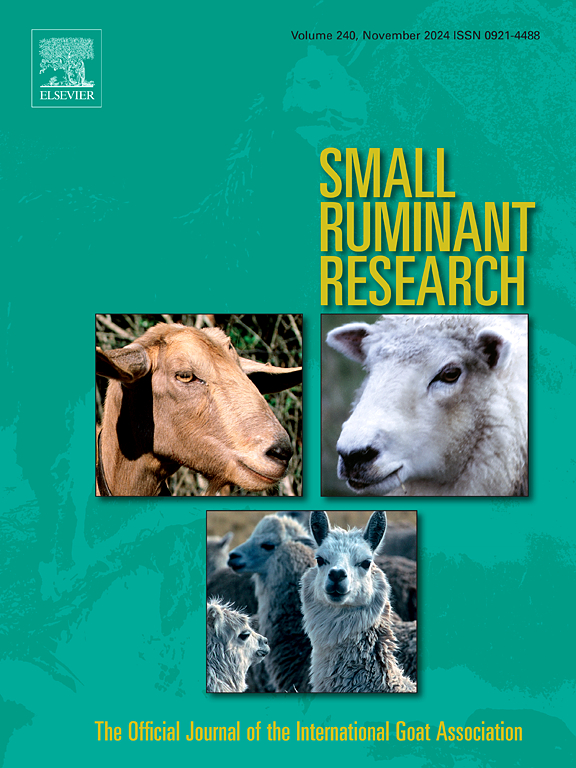Comprehensive survey of caseous lymphadenitis in sheep and goats flocks of Iran: Clinical, bacteriological, and molecular insights
IF 1.6
3区 农林科学
Q2 AGRICULTURE, DAIRY & ANIMAL SCIENCE
引用次数: 0
Abstract
Caseous lymphadenitis (CLA) is a chronic and highly contagious disease in sheep and goats caused by Corynebacterium pseudotuberculosis, resulting in significant economic losses in the livestock industry. Despite its global prevalence, studies on CLA at the flock level in Iran remain limited. This study aimed to investigate the prevalence and epidemiology of CLA in sheep and goat herds across all 31 provinces of Iran using clinical, bacteriological, and molecular diagnostic methods to inform effective control and management strategies. This cross-sectional study, conducted from 2017 to 2022, investigated CLA prevalence in sheep and goat herds across all 31 provinces of Iran. Using a stratified sampling approach, 120 herds per province were selected and categorized by size into small (<70 animals), medium (70–150 animals), and large (>150 animals) groups, ensuring diverse representation. Clinical examinations and microbiological analyses identified cases, while multiplex PCR confirmed the presence of C. pseudotuberculosis. Statistical methods assessed associations between flock size, species, and age. The study revealed distinct prevalence patterns of CLA across Iranian provinces, with low prevalence (<5 %) observed in over 30 % of flocks, moderate prevalence (5–10 %) in 20–50 %, and high prevalence (>10 %) in less than 15 %. Clinical signs were primarily observed in the prescapular and submandibular lymph nodes, with lesions confirmed by bacteriological and molecular methods. C. pseudotuberculosis was the primary causative agent, with other secondary pathogens occasionally identified. Multiplex PCR successfully confirmed C. pseudotuberculosis in all positive samples. This study highlights the localized prevalence of CLA across Iran, identifying areas of high prevalence that necessitate urgent intervention. The findings underscore the importance of integrating effective vaccination strategies, biosecurity measures, and early detection protocols to manage CLA and reduce its economic impact. Future efforts should prioritize developing and implementing region-specific vaccines and preventive measures in Iranian herds.
伊朗绵羊和山羊群干酪样淋巴结炎的综合调查:临床,细菌学和分子见解
干酪样淋巴结炎(CLA)是由假结核棒状杆菌引起的绵羊和山羊的一种慢性和高度传染性疾病,给畜牧业造成重大经济损失。尽管CLA在全球流行,但在伊朗的种群水平上对CLA的研究仍然有限。本研究旨在通过临床、细菌学和分子诊断方法调查伊朗所有31个省绵羊和山羊群中CLA的患病率和流行病学,为有效的控制和管理策略提供信息。这项横断面研究于2017年至2022年进行,调查了伊朗所有31个省绵羊和山羊群中CLA的流行情况。采用分层抽样方法,每个省选择120个畜群,并按规模分为小型(70头)、中型(70 - 150头)和大型(150头)组,以确保多样化的代表性。临床检查和微生物学分析确定了病例,多重PCR证实了假结核杆菌的存在。统计方法评估了群的大小、种类和年龄之间的关系。该研究揭示了CLA在伊朗各省的不同流行模式,在30 %以上的鸡群中观察到低患病率(> 5 %),在20-50 %中观察到中等患病率(> 5 %),在15 %以下观察到高患病率(>10 %)。临床症状主要见于包膜前和下颌下淋巴结,病变经细菌学和分子方法证实。假结核杆菌是主要病原体,偶尔发现其他继发病原体。所有阳性标本均经多重PCR证实为假结核杆菌。这项研究强调了CLA在伊朗的局部流行,确定了需要紧急干预的高流行地区。这些发现强调了整合有效的疫苗接种策略、生物安全措施和早期发现方案以管理CLA和减少其经济影响的重要性。今后的努力应优先考虑在伊朗畜群中开发和实施特定区域的疫苗和预防措施。
本文章由计算机程序翻译,如有差异,请以英文原文为准。
求助全文
约1分钟内获得全文
求助全文
来源期刊

Small Ruminant Research
农林科学-奶制品与动物科学
CiteScore
3.10
自引率
11.10%
发文量
210
审稿时长
12.5 weeks
期刊介绍:
Small Ruminant Research publishes original, basic and applied research articles, technical notes, and review articles on research relating to goats, sheep, deer, the New World camelids llama, alpaca, vicuna and guanaco, and the Old World camels.
Topics covered include nutrition, physiology, anatomy, genetics, microbiology, ethology, product technology, socio-economics, management, sustainability and environment, veterinary medicine and husbandry engineering.
 求助内容:
求助内容: 应助结果提醒方式:
应助结果提醒方式:


